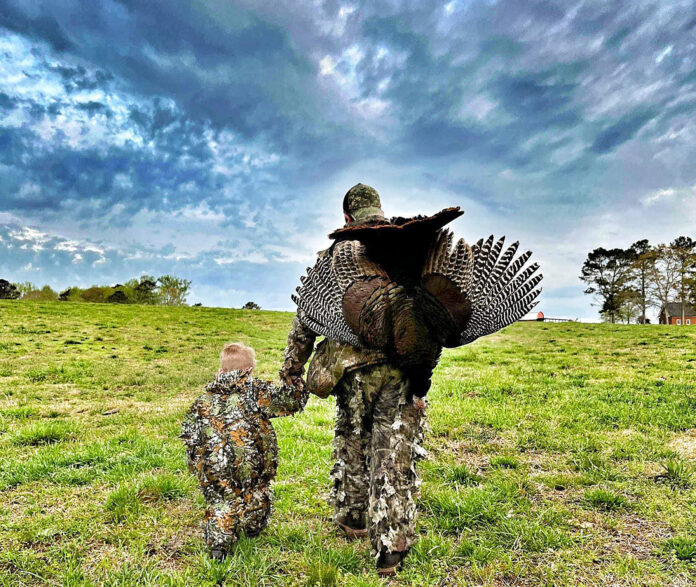
MONTGOMERY, Ala. – According to Game Check reports, turkey hunters in Alabama harvested almost 2,500 more birds during the 2023 season than the 2022 season. Whether that’s an encouraging indication of the turkey population in the state is subject to significant debate.
Hunters reported taking 18,122 birds during the 2023 season, compared to 15,673 during the 2022 season and 14,947 during the 2021 season. Those are Game Check numbers, and Steven Mitchell, the upland game coordinator with the Alabama Department of Conservation and Natural Resources’ (ADCNR) Wildlife and Freshwater Fisheries (WFF) Division, said the results of the annual post-season hunter survey are not yet available. Mitchell is concerned that hunters are not reporting their harvests through Game Check as mandated.
“Our compliance rate on reporting is not where it needs to be,” Mitchell said. “Comparison of Game Check numbers with post-season harvest surveys gives us an estimated reporting compliance rate. Since implementation of Game Check in 2017-18, harvest reporting compliance has been increasing with each season. However, we are only averaging a 45% compliance rate over the last five years. That rate needs to be much higher. Compliance with harvest reporting is extremely important. We need the most complete and accurate data possible to help inform management of the wild turkey resource.”
Chuck Sykes, WFF Director, also said this trend in turkey harvest cannot necessarily be construed as an increase in the turkey population.
“That remains to be seen,” Sykes said. “That could be a really good thing, meaning that we’ve got more birds. But we’ve also got more hunters out there. To me, we’ve got more hunters who are taking more birds.”
Sykes said he focused on the first 10 days of the past three seasons to illustrate the increase in hunters compared to turkey harvest numbers. During the opening 10 days of the 2021 season 3,808 hunters reported 4,488 birds harvested. The same time period for the 2022 and 2023 seasons showed significant increases in hunters (6,062 hunters in 2022 and 6,325 in 2023) and a corresponding increase in reported harvests (7,391 in 2022 and 7,845 in 2023).
“We’ve got more hunters each year, killing more turkeys,” Sykes said. “So does that mean there are more turkeys out there. I don’t think so. Only time will tell.”
Sykes said what concerns him is the motivation of today’s turkey hunters compared to previous generations.
“Back in the day, you hunted turkeys for the challenge,” he said. “I’m not saying I didn’t like killing turkeys, but it was different. I don’t see that today. I’m not saying everybody. No matter what rules and regulations we put in place, no matter what science we come up with, we can’t legislate or regulate morals and ethics. Rules and regs are only as good as people who abide by them.”
Sykes said he studied the contacts the WFF Conservation Enforcement Officers had with turkey hunters during the first 10 days of the 2023 season, and it was disheartening.
“The number of citations written was embarrassing,” he said. “More than half the counties had citations written in them.”
Those game violations included hunting without a license, adults hunting during youth weekend, hunting prior to the opening of the season and using decoys the first 10 days of the season.
“But the biggest one was hunting over bait,” Sykes said. “We had more than 80 citations written for hunting by the aid of bait in the first 10 days. If we wrote that many, how many were doing it? I think people’s mindsets have changed to ‘I just want to kill turkey under any circumstance so I can post the picture or video on social media.’
“I hope I’m wrong. It just seems that the lines between right and wrong are very blurred right now.”
Sykes said modern technology has become so sophisticated that the sense of fair chase has been marginalized.
“Like using a cell phone-activated trail camera, not just to scout, but to see a turkey and go try to kill him,” he said. “Back in the day, if a turkey didn’t gobble but once or twice on the limb, he had a good chance of making it. That was a defense mechanism. You might have hunted him all season. Now, with the cell phone-activated trail camera alerting you every time a turkey walks by, whether he gobbles or not, you can still kill him.
“I’m not saying all technology is bad. I’m using a .410 now that shoots better than 12 gauges that I hunted with for 25 years. You’ve got Thermacells and turkey loungers and lightweight guns. We’ve got to take into account that people are much more effective killers. If you throw out the illegal activities, just the legal hunting methods are making people much more effective killers, and I don’t think people are giving that the attention it needs.”
For veteran hunters who remember when the turkey population in Alabama was not abundant, an outing where a hunter heard a turkey gobble was considered a successful hunt.
“It doesn’t seem like that’s the case anymore,” Sykes said. “I think until people respect the bird and love the hunt and love the bird more than they love themselves, the birds are in trouble. People are turkey shooters now, not turkey hunters.
“I didn’t grow up that way, and a lot of people of our generation can’t understand that mentality. That’s what I see. Again, I hope I’m wrong. I will gladly say that I am.”
Meanwhile, Mitchell thinks social media does have one upside for Alabama’s Eastern wild turkey.
“Social media has drawn more people into turkey hunting,” Mitchell said. “I don’t think that is necessarily a bad thing. I think a lot of it has called attention to the plight of turkeys and the perceived turkey decline. I think or hope people have gained education through social media more than anything.”
Mitchell said turkey hunters during the 2023 season enjoyed relatively cool temperatures, which can mean more comfortable hunting conditions later in the season.
“It may have helped the gobblers as far as gobbling and displaying later into the mornings,” he said. “We also had an early spring as far as vegetation. From anecdotal reports I’m getting from around the state, nests were being observed earlier than previous years. Hopefully that translated into a good hatch. The earlier the nest, the more of a likelihood a brood will successfully hatch young.”
WFF personnel will conduct its annual statewide brood survey from July 1 through August 30, when all turkey sightings are noted on field reports that include gobblers, hens without poults, hens with poults, the size of the poults and poults per hen.
“Ultimately, that gives us a poult-per-hen count,” Mitchell said. “That gives an indication of how good our hatch was and juvenile recruitment into the fall population. Last year’s survey showed we were still below what researchers consider the threshold for sustainable population, which is two poults per hen. Unfortunately, we have been below that threshold for several years now.”
Mitchell said many of the hunters he has talked to about the 2023 season considered it a “pretty good” season with a decent amount of gobbling activity.
“Most of them don’t think it’s what it used to be, our numbers are not what they used to be, but they’re not panicking,” he said. “They’re still hearing gobblers and hunting gobblers, but that was the slight majority. Other have stated their hunting was way down in terms of hearing gobblers and gobbles.”
“Anecdotal reports from landowners and land managers have been varied. Some have said they have not noticed a drop in turkey numbers while other landowners have noted a decrease in turkey numbers over previous years.”
The 2023 season has been over for almost two months, but Mitchell said landowners and leaseholders can use the offseason to be proactive about increasing beneficial habitat for turkeys on their properties.
“It’s habitat first and predator control as basically a steroid,” he said. “It’s about getting that habitat in a healthier condition to provide benefits for the wild turkey. After that, they can provide more benefit through trapping predators.
“Right now is a great time to identify habitat needs. A lot of times the limiting factor is brooding habitat or bugging habitat for the poults. People may not like the look of a weedy mess around their property, but that’s where those young turkeys survive.”
Mitchell also said the density of weedy growth can be a detriment to poult survival as well.
“If a poult cannot easily move through that vegetation to forage for bugs and escape predators, that is not good,” he said. “The density of that vegetation is very important. If it’s choked up with grasses, you might look at prescribed fire or disking. Everything is important at ground level.
“Thinning timber in places where sunlight is not getting to the ground will also help provide brooding and nesting areas. Everybody needs to think ‘habitat’ because that’s the key.”


















